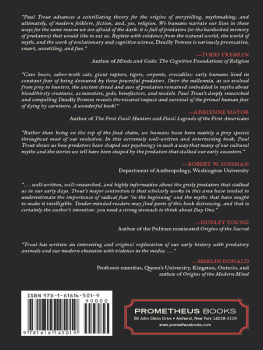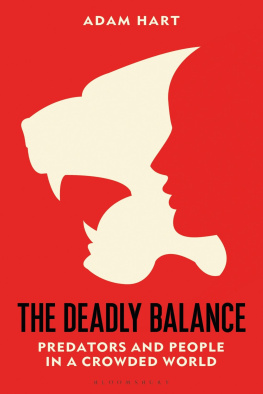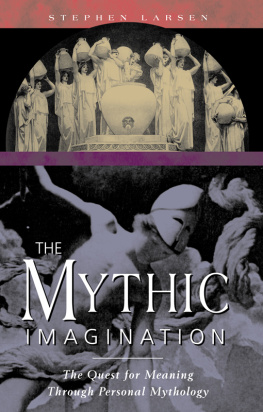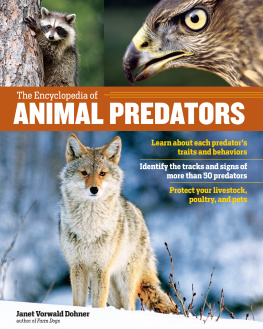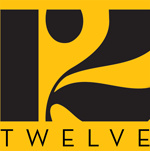Ehrenreich - Deadly powers: animal predators and the mythic imagination
Here you can read online Ehrenreich - Deadly powers: animal predators and the mythic imagination full text of the book (entire story) in english for free. Download pdf and epub, get meaning, cover and reviews about this ebook. City: Amherst;N.Y;Brighton, year: 2012, publisher: Random House Publisher Services;Prometheus, Roundhouse [distributor], genre: Romance novel. Description of the work, (preface) as well as reviews are available. Best literature library LitArk.com created for fans of good reading and offers a wide selection of genres:
Romance novel
Science fiction
Adventure
Detective
Science
History
Home and family
Prose
Art
Politics
Computer
Non-fiction
Religion
Business
Children
Humor
Choose a favorite category and find really read worthwhile books. Enjoy immersion in the world of imagination, feel the emotions of the characters or learn something new for yourself, make an fascinating discovery.
- Book:Deadly powers: animal predators and the mythic imagination
- Author:
- Publisher:Random House Publisher Services;Prometheus, Roundhouse [distributor]
- Genre:
- Year:2012
- City:Amherst;N.Y;Brighton
- Rating:3 / 5
- Favourites:Add to favourites
- Your mark:
- 60
- 1
- 2
- 3
- 4
- 5
Deadly powers: animal predators and the mythic imagination: summary, description and annotation
We offer to read an annotation, description, summary or preface (depends on what the author of the book "Deadly powers: animal predators and the mythic imagination" wrote himself). If you haven't found the necessary information about the book — write in the comments, we will try to find it.
Deadly powers: animal predators and the mythic imagination — read online for free the complete book (whole text) full work
Below is the text of the book, divided by pages. System saving the place of the last page read, allows you to conveniently read the book "Deadly powers: animal predators and the mythic imagination" online for free, without having to search again every time where you left off. Put a bookmark, and you can go to the page where you finished reading at any time.
Font size:
Interval:
Bookmark:

Praise for Deadly Powers
While mythological studies routinely look back to ancient Mesopotamia, Egypt, or Greece, this author pushes back to the Pleistocene. There, he suggests, as Homo sapiens developed and experienced their impotence before carnivorous beasts up to two tons in mass, fear was of course the primary response. As language developed, primordial storytelling flourished, and eventually myth. This is a strongly researched, insightful volume treating themes from across the world.
William G. Doty, professor emeritus, University of Alabama
and author of Mythography: The Study of Myths and Rituals
and several other books in the field
Living as many of us do in safe, modern surroundings, it's easy for us to forget how large predators have loomed over human lives during most of our species' history on earth. In Deadly Powers, Paul Trout brings together science and art to remind us how important predators have been in shaping our literatures, our imaginations, and even our minds. If you've ever wondered why you can't get enough of zombies, werewolves, and aliens, this is the book for you.
Clark Barrett, associate professor of anthropology,
University of California, Los Angeles


Published 2011 by Prometheus Books
Deadly Powers: Animal Predators and the Mythic Imagination. Copyright 2011 by Paul A. Trout. All rights reserved. No part of this publication may be reproduced, stored in a retrieval system, or transmitted in any form or by any means, digital, electronic, mechanical, photocopying, recording, or otherwise, or conveyed via the Internet or a website without prior written permission of the publisher, except in the case of brief quotations embodied in critical articles and reviews.
Cover illustration Hercules and the Hydra of Lerne by Gustave Moreau
used by permission of Bridgeman Art Library/SuperStock
Cover design by Nicole Sommer-Lecht
Inquiries should be addressed to
Prometheus Books
59 John Glenn Drive
Amherst, New York 142282119
VOICE: 7166910133
FAX: 7166910137
WWW.PROMETHEUSBOOKS.COM
15 14 13 12 11 5 4 3 2 1
Library of Congress Cataloging-in-Publication Data
Trout, Paul A., 1940
Deadly powers : animal predators and the mythic imagination / by Paul A. Trout.
p. cm.
Includes bibliographical references and index.
ISBN 9781616145019 (cloth : alk. paper)
ISBN 9781616145026 (ebook)
1. AnimalsFolklore. 2. AnimalsMythology. 3. Predatory animalsFolklore.
4. Predatory animalsMythology I. Title.
GR705.T762011
398.24'5dc23
2011028692
Printed in the United States of America on acid-free paper


T his book is the most ambitious survey to date of the relationship between humans and the wild carnivores that preyed on them as long as Homo sapiens, or our hominid ancestors, have existed. I first started thinking about animal predation on humans while researching my 1998 book Blood Rites: On the Origins and History of the Passions of War, and argued in that book that, in many ways, especially those involving the use of violence, human nature has been shaped by our long, terrifying history as the prey of creatures far bigger, faster, and better armed in the tooth-and-claw department than our distant ancestors were. In Deadly Powers, Paul Trout goes over some of the same groundwith generous acknowledgments of my work, I should notebut he has far more material to work with and takes it in some novel directions.
He begins with a bracing catalog of some of the more formidable creatures our Stone Age ancestors had to contend with. There were far bigger cats than we can imagine today, such as the New World sabertooth tiger, which sported ten-inch long tusks and weighed over 750 pounds, twice the weight of African lions today. Bears were another problem, especially the now-extinct American short-faced bear, which was eleven feet tall when it stood on two legs. Human residents of Paleolithic Egypt had to worry about snakes up to 65 feet long weighing in at about 800 pounds, and early Australians faced Megalania, a 30-foot-long, 2,000-pound carnivorous lizard. As for the canids that today are increasingly employed as therapy dogs, Trout reminds us that hunting in packs, they were as dangerous as any single big cat. He supplements this nightmare bestiary with archaeological evidence for predation on early humanshominid skulls pierced by holes spaced at the exact distance between the teeth of Pleistocene leopards, for examplewhich were at first mistakenly attributed to intra-hominid homicide.
But for all we know, early humans may have been an especially delectable carnivore snack. Trout reports that in many African myths, humans are casually referred to as the meat without hair.
The reasons to think that early humans were preyed upon have mounted over the years. Wild primates, including our close relatives the chimpanzees, are preyed upon today, as proved by the presence of their DNA in the scat of leopards and lions. It is now widely accepted that the exigencies of predation are a major factor in making us, like most other primates, social animals, whose ultimate reason to stick together is for mutual defense. An individual is more likely to survive in a noisy, fast-moving group than as a solitary creature in the wild, which is why, for example, fish swim in schools. In addition, group living offers opportunities for more aggressive forms of collective defense: Monkeys may mob a predator; young baboon males sometimes sacrifice their lives in an effort to drive a predator away from the females and young.
While some scientists have, like Leakey, been queasy about predation on humans, classicists, folklorists, and the like can hardly ignore it. If there is one central human mythological theme, from Gilgamesh to Beowulf, it is of the human-eating creature that ravages the countryside until someonehero or godsuccessfully confronts it. The predator in these stories is often dismissed as a symbol for some entirely human fantasy or preoccupation. But as Trout argues, human storytelling, and hence literature, grew out of encounters with real animal predators and served as a means of fear management as well as a means to ready the group for future encounters. Lions, for example, were a real and widespread threat to humans into historical times. When the Achaean heroes weren't fighting Trojans, Homer tells us that they were tasked with trying to keep their kingdoms lion free. Tigers took a huge toll on humans in India well into the nineteenth century, leaving large swaths of the subcontinent uninhabitable for humans, and they still do in the Sundarbans, where every village has its tiger widows. In Eurasia, wolves not only preyed on travelers but threatened rural villagers well into the eighteenth century.
Deadly Powers does not skimp on the horrors of being eaten alive. Sometimes predation is a silent affair, as when a giant snake swallows a victima child, for examplewhole. But predators may emit terrifying soundsthe roars of big cats, the growls of wolves or hyenas, the sonic shrills of attacking raptorsfor the apparent purpose of causing their prey to freeze. As for the prey, Trout tells us, Some of them snort, some bellow, some bray, some screech, some bleat, some shriek, some scream, some squeal, and some wail, as they protest being clawed, bitten, eviscerated, and dismembered. Surviving conspecifics may find few fragments of the victim left to mourn, or they may find too many. Trout reports that one of the most horrifying collections of stomach contents taken from an African crocodile included eleven heavy brass arm rings, three wire armlets, wire anklets, a necklace, fourteen human arm and leg bones, and three human spinal columns. And, he reminds us, the ultimate humiliation, referred to in myth after myth, is to be eaten and then passed out as excrement.
Font size:
Interval:
Bookmark:
Similar books «Deadly powers: animal predators and the mythic imagination»
Look at similar books to Deadly powers: animal predators and the mythic imagination. We have selected literature similar in name and meaning in the hope of providing readers with more options to find new, interesting, not yet read works.
Discussion, reviews of the book Deadly powers: animal predators and the mythic imagination and just readers' own opinions. Leave your comments, write what you think about the work, its meaning or the main characters. Specify what exactly you liked and what you didn't like, and why you think so.

